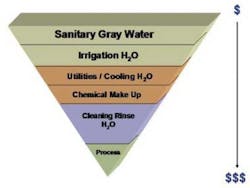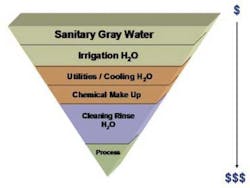Stormwater can act as the ultimate vehicle for transferring litter from urban environments to seas. Waterway collection systems are becoming crucial to reduce the environmental damage caused by rubbish. Gary Hopkins looks at an Australian municipality that employed a variety of methods in the battle for clean waterways.
Our modern society lives by an "out of sight, out of mind" mentality. However, with almost seven billion people globally, litter has become an epidemic that can no longer be ignored. At some point in history, civilized society has turned into a disposable society creating immeasurable amounts of gross non-point source pollution. This specific type of pollution occurs when any type of precipitation (stormwater) runs over land, picks up trash and eventually deposits it into rivers, lakes, and oceans. People and governments worldwide are now paying attention to the damage this human behavior has caused and are taking measures to control the world's pollution problem.
Although this is a global dilemma, the United States has clearly caused more harm than any other single nation. Ultimately, this trash and debris ends up in our oceans, having harmful effects on marine and wildlife. While it has been easy for many to overlook animals that ingest plastics or become entangled in human litter, the world is beginning to recognise the detrimental effects that unhindered disposal has caused. Algalita Research Foundation has brought international attention with the discovery of the Great Pacific Garbage Patch, which is defined as a "high concentration of debris in the northeastern corner of the North Pacific Subtropical Gyre". The patch extends from 500 nautical miles from the West Coast of the United States through the Pacific Ocean nearly reaching the coast of Japan (Marks, Kathy and Daniel Howden - (1)).
Among the worst culprits of litter in waterways are single use plastics. When exposed to UV rays, these plastics do not biodegrade, but instead photodegrade. The movement of plastics from users to wildlife can be easily followed, with stormwater serving as the ultimate vehicle. Governments and individuals around the globe are taking action to keep gross pollutants out of waterways. The United Nations Convention on the Law of the Sea (UNCLOS) obliges governments to take measures to prevent, reduce and control pollution of the marine environment from land-based sources. Laws are being enacted around the globe to prevent the production of single use plastics, even in the United States where convenience is a way of life.
Capturing the litter early in the process greatly reduces environmental damage. Among the products being used today to stop the flow of litter are storm drain covers, catch basin inserts, full-capture storm drain netting systems, litter trap boom systems and various collection systems for waterways. Municipalities worldwide have learned that until human habits change, these devices must be used in conjunction with each other in order to keep gross pollutants out of bodies of water to stop harm to marine life, wildlife and ultimately humans.
FLOW RATE CALCULATIONS The StormX calculator allows engineers the opportunity to model an installation of this product by entering variables to calculate design flow rates as well as overflow capacity. The design flow rate is calculated by entering a watershed area, in acres, along with weighted runoff coefficient and design storm intensity. The overflow capacity for a weir wall assembly is calculated by entering the length of a wall, along with the ponding above the wall weir coefficient. To calculate the performance of StormX, an engineer simply enters pipe diameter, wall height, the number of units, and fullness of net to calculate capacity. In order to check against both of these occurrences, the civil site engineer should adjust the hydraulic grade line assumptions with the dynamic storm water model to account for higher discharge tailwater and check for flooding in the system. |
Case Study - Sydney, Australia
While the population concentration in an urban area naturally increases the amount of gross pollutants, it's the city's infrastructure that provides numerous opportunities for removing trash, litter and other unwanted debris at key collection points.
In Sydney, Australia when one municipality decided to halt the flow of unwanted litter and debris they employed a variety of methods and found a powerful tool in the battle for clean waterways was the StormX, or the Pratten Trap as it's known locally.
The StormX full capture netting system is constructed of stainless steel hubs anchored into concrete for a weir configuration or secured directly to concrete or steel pipe outfalls with reusable commercial grade nets. Trash and debris flows with storm water runoff into the system where the nets capture the trash and allow the water to continue to flow unimpeded. Due to the structure of the specific drainage outlet, the municipality uses both full-pipe as well as weir designs with a trash rack on top, which are designed to capture trash and debris during overflows in peak rainfall events.
The traps have been highly successful in collecting gross pollutants and have been well received as an inexpensive control with lower ongoing cleaning and repair compared to other types of proprietary gross pollutant traps. To date the only net replacement required for the product has been as a result of deliberate vandalism. Minimal maintenance has been required to re-thread wire cable or cord through the mesh.
Stopping the movement of gross pollutants is the focus of most devices employed to combat litter but it's cleaning out the pollutants that can be problematic. Many of the StormX/Pratten Traps in the area have a sediment storage area which allows for an increased capture rate resulting in a decreased frequency in the need to clean the device annually. The municipality employs an "as needed" system for emptying the StormX/Pratten Trap nets and schedules clean-outs approximately every three months, depending upon the watershed area and load. It takes between one and two hours for three men and a crane to empty the netting system, depending on the volume of debris captured and the antecedent rainfall.
As one of many tools used by the city, the device has proven to be a cost effective and long lasting solution for capturing gross pollutants once they enter a central location - the storm drain system. StormX/Pratten Trap has been successfully used throughout Australia for 15 years. WWi
References:
1 - Kathy Marks, Asia-Pacific Correspondent, and Daniel Howden. "The Independent" "The world's rubbish dump: a tip that stretches from Hawaii to Japan. 5 Feb 2008. Retrieved: 25 July 2010.
Author's note:Gary Hopkins is the president of Storm Water Systems.
More Water & WasteWater International Current Issue Articles
More Water & WasteWater International Archives Issue Articles




